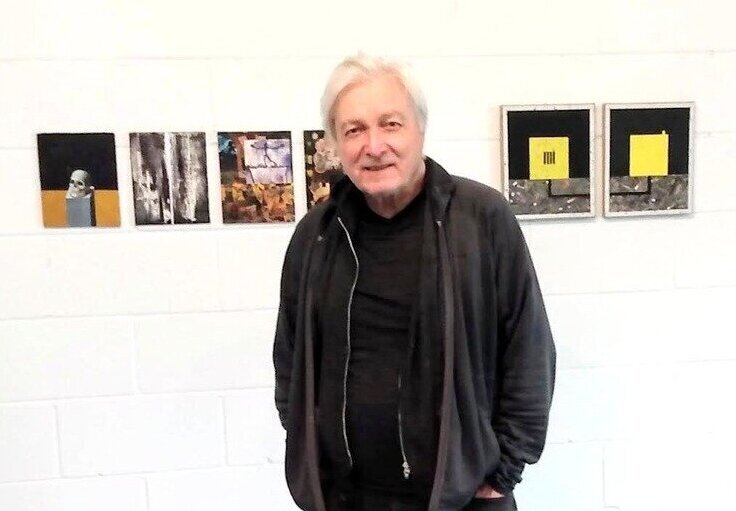For over two decades artist, Steve Rockwell, has published dArt Magazine. His intimate involvement in the magazine – both editing and writing for it – has informed his works currently on display at Station Independent Projects, an exciting new gallery on Geary Avenue, that has its origins in Lower East Side, NYC. The show has been given the title ‘DArt Magazine Curated Content’ because all the works on exhibit derive their content from the pages of the magazine itself. More exactly, every image is lifted from the magazine, and is incorporated in a collage, or is altered by being painted over somehow.
Steve Rockwell in front of his works. Photo: Leah Oates
As described above, it might appear that Rockwell has baldly appropriated images of various artworks. Things are not so straightforward. It seems to me, at least, that Rockwell’s immersion in the artworld is so total that almost all the imagery, that appear in his magazine anyway, bears some relation to his life. In this sense the content has a personal dimension to it. Rockwell himself remarked that he aimed to disappear behind the works – art as self-effacement. But listening to him relating the connections he has to what is on display, the opposite might be asserted, namely that he reveals himself through the works. He makes the images his own in this regard.
(L-R) Dead Idiot, Pencke’s Passage, Richter Scale, Card Players
There is no sense, then, in which he is plagiarising or wilfully pilfering images. As well, the creative way in which he uses the images allays this worry. One is reminded of how T.S. Eliot was once accused of almost wanton appropriation in his poem The Waste Land no less, given that he quoted so many poets in this work. Yet, of course, Eliot demonstrated how merely using others’ works in no way indicates a lack of creativity on the part of the author. Ditto with Rockwell. He is thoroughly conversant with the ideas behind the images he deals with, aided by his dazzling knowledge of art history. Indeed, there is a poeticism to Rockwell’s work – something quite refreshing given that art today is often flatly literal, even moralistic in tenor. The way he deviates from any straightforward reading of the images he uses could be aptly characterised as metaphorical.
(L-R) Hirst’s Anatomy, Burning Man, The Pharmacist, Miami Flurry
The principal works on display consist of a series of eight suites of four pieces. Each suite (or ‘stanza’ one might say) is grouped together on the wall, and is loosely connected by a theme, e.g., food, medicine or water. All the pieces are consistent in size, measuring 8.5 inches by 7 inches. That happens to be the same size as the dArt Magazine. This fact reflects Rockwell’s penchant for setting himself rules concerning the production of his work. The idea that art ought to be done according to a set of rules likely seems anathema to artistic creativity. But, here it is important to note the distinction between self-imposed private rules, like those set by Rockwell, and those rules set by others that most often shape our conventional social behaviour. The latter type are often constraining, but the former type of rules can in fact be liberating – they are a creation of the artist after all. They allow the artist to focus on those elements that he is interested in. The result in Rockwell’s case, is that his works show a high degree of freedom within the bounds he has set himself.
(L-R) As the World Grinds, Pulp Ladle, The dArt Burger, The Bunny Show
Rules very often are manifest in games, broadly construed. Games epitomise rule-following activity as such. And these have been an ongoing theme of Rockwell’s work over the years. He has on several occasions in the past devised his own games that result in an exhibitable artwork. One example is his work titled ‘Gallery Space’ (1988) – not shown here. Inspired by Sol Le Witt and his conceptual exploration of fundamental forms, Rockwell planned a grid-like sculpture. After canvassing the participation of galleries in Toronto, he sent a form to the director of each. On it he requested the director to choose an available square on the eight by eight grid and, as well, to indicate whether the main door is located on the north, east, south or west wall. After gathering all this infomation he set about constructing a six feet by six feet sculptural model, showing the name of each gallery in its chosen grid and a hole made in the respective wall. As with Sol Le Witt’s work, Rockwell’s sculpture is in essence the embodiment of an idea, where its physical details ‘take care of themselves’ in virtue of the rules he devises.
As evidenced by the example cited above, rules demand an inventiveness and humour in their construction. And these qualities are amply betrayed in the works in this show. For instance, in the final piece of his third suite, an image of the artist Augustus Johns is placed on a background consisting of three vertical stripes. It looks as though Johns, holding a small sable brush, has absurdly just completed a wall-sized abstraction. In the first piece in this suite Rockwell has cheekily taken a reproduction of a small painting by Edward Hopper and extended the sky and foreground to fit his chosen vertical format.
(L-R) Hopper’s Corn Hill, Stipl Squint, Jaan’s Divide, Johns Paint Tip
Although these pieces at times touch on darker subjects, they certainly cannot be called saturnine, say. Rather, over all they are playful, reflecting Rockwell’s mercurial and lively intellect. They are a celebration of art and life. You don’t want to miss this one.
Hugh Alcock
Images are courtesy of the artist
*Exhibition information: Steve Rockwell, DArt Magazine Curated Content, March 1 – 16, 2024, Station Independent Projects, 220 Geary Avenue, #2B, Toronto. Gallery hours: Thurs – Sun 1 – 6 pm.





